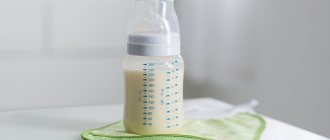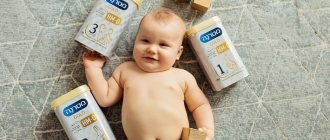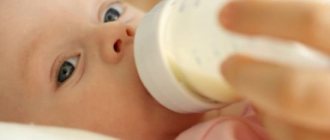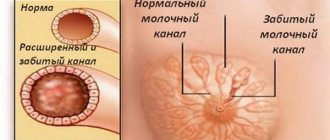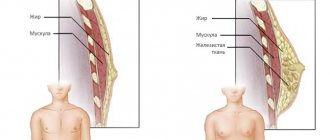Breastfeeding experts believe that every woman is capable of breastfeeding. However, if a young mother is unable to establish lactation or breastfeeding is impossible for medical reasons, then the baby will be fed with formula milk. Of course, artificial feeding cannot replace breastfeeding, but if necessary, it will be a good alternative. And here many mothers have a question, which milk formula to choose for a newborn, the composition of which is as close as possible to the composition of breast milk.
Composition of infant formula
In terms of its composition, no infant formula can completely replace breast milk. Even the most famous ones are only a complex organic-chemical product. To ensure that their composition matches breast milk as closely as possible, special components are added to them that help the baby’s body develop, grow and fight infectious diseases correctly.
What important beneficial substances do infant formula contain:
- Squirrels . Breast milk contains from 0.8 to 1.2 grams of protein per 100 grams. Some manufacturers believe that its content should be slightly higher than in human milk, since cow's protein is less digestible. Other manufacturers add 1.2 grams of protein per 100 grams to the product, thereby trying to bring this amount as close as possible to the amount in breast milk. However, most still contain 1.4 grams of this substance.
- The ratio of whey proteins to casein is an important indicator of the degree of adaptability of the product. Breast milk has a ratio of 80:20 to 60:40. This indicator must be present in infant formula intended for children under 6 months. If there is more casein, then it is considered casein and is not adapted.
- Taurine . This amino acid is added to all mixtures. It is necessary for the development of vision, the nervous system, and also for better absorption of fats. Its quantity is 4-5 g per 100 g.
- Vegetable oils . Several types of vegetable oils (palm, rapeseed, soybean, sunflower, coconut) are added to all milk mixtures. Some manufacturers (Similak, Nanny) do not add palm and rapeseed oil to their product, considering them harmful to the child’s body. However, these oils are approved for infant nutrition.
- Fatty acids (linolenic, linic, docosohexaenoic, eicosopetaenoic) . They are necessary for the construction and functioning of cells, the development of the brain and retina.
- Lactose (milk sugar) . Important for children's development. Lactose improves digestion processes, improves the absorption of minerals, and promotes the development of lacto and bifidobacteria.
- Prebiotics . Promotes the growth of beneficial bacteria in the intestines.
- Probiotics . Helps digestion, strengthens the immune system, fights allergies and infections.
- Nucleotides . These substances are important for the development of a child, they are involved in metabolism, the construction of DNA, RNA, and strengthen the immune system.
- Vitamins and minerals . More vitamins and minerals are added to all milk formulas than are present in breast milk, since their absorption is slightly worse.
- Kholin . The substance is necessary for the nervous system.
Table comparing the composition of popular infant formulas with breast milk
Dry or liquid complementary foods contain some protein, fat and carbohydrates. Approximate indicators:
| Indicators | Breast milk | Agusha | Semper | Hipp |
| Squirrels | 0,9-1,5 | 1, 3 | 1,4 | 1,4 |
| Fats | 3,6 | 3,3 | 3,3 | 3,2 |
| Carbohydrates | 7,6 | 3,3 | 7,4 | 7,4 |
| Vitamins (A, B, E) | yes (+) | + | + | + |
| Minerals | yes (+) | + | + | + |
These products contain almost the same elements as in breast milk: biotin, folic acid, carnitine, choline, taurine, niacin. Nutritional value ranges from 65-75 kcal.
Types of infant formula
Stores and pharmacies offer a wide range of milk formulas for babies. Even an experienced mother can get confused in the choice. Therefore, below we will consider what they are.
The consistency of baby formulas is
Liquid - ready-to-eat food that just needs to be heated. They are packaged in special Tetra Pak packaging, in a volume of 200 ml. Pros: balanced proportions, sterility, saving time during preparation. Cons: short shelf life, expensive, difficult to find in stores.
Dry - in powder form, which are diluted with warm boiled water in the required proportions. The powder is packaged in a cardboard box or metal can, in a volume of 350 to 1200 g (depending on the manufacturer). They can be easily found in stores and pharmacies, have a long shelf life, and are easy to use and transport.
According to the age
When choosing infant formula, you must take into account the age of the baby. Manufacturers indicate the following number on the packaging:
- 0 or “pre” - for premature or low birth weight babies,
- 1 - for babies from birth to 6 months,
- 2 - for children from 6 months to 1 year,
- 3 - for children over 1 year old.
Based on their composition, infant formula is divided into:
- Adapted . Designed for children from birth to 6 months. Their composition is as close as possible to breast milk and contains all the necessary elements for the proper development and growth of the baby.
- Partially adapted . Such mixtures contain a higher content of protein, vitamins and minerals, as well as starch and sucrose. They are higher in calories and are intended for children from 6 months.
- Unadapted . The mixture is made from milk powder. Additionally, the same components are added to it as in adapted and partially adapted ones. The composition also contains casein, which is poorly absorbed in the baby's body. Therefore, they should be introduced into the child’s diet after 8 months.
According to medicinal properties
Therapeutic milk formulas are intended for children who have health problems.
- Fermented milk products . Prescribed to children in addition to nutrition (1-2 times a day) for problems with the gastrointestinal tract (dysbacteriosis, intestinal infection, colic, diarrhea, constipation, rickets, reduced immunity).
- For premature and low birth weight babies (less than 3 kg) . Such mixtures contain large amounts of protein, carbohydrates, fats, vitamins and minerals.
- Hypoallergenic . Prescribed to a child prone to an allergic reaction caused by a previously consumed mixture. Hypoallergenic does not contain cow's milk protein, and its nutritional composition is no different from regular milk. Instead, hydrolyzed protein is added.
- Antireflux . Prescribed to children who frequently burp. The mixture contains special components that make it thicker and prevent its release from the stomach.
- Lactose-free . Contains no lactose. Indicated for infants with lactase deficiency (lactose intolerance) - the inability of the child’s body to digest milk sugar.
- Soybeans . The composition, instead of cow's milk protein, contains soy protein isolate obtained from soybeans. Prescribed to a child with food allergies if a hypoallergenic formula is not suitable.
- With high iron content . Indicated for children over 4 months of age for the prevention and treatment of iron deficiency anemia. The pediatrician will prescribe the mixture if the level of hemoglobin in the child’s blood is low. Iron supplements are also prescribed additionally.
When choosing a formula for your child, you should first consult with your pediatrician!
How to calculate the ratio of mixture and milk
Most young parents are interested in whether their baby eats enough substitute?
With excessive consumption of baby substitute, the following symptoms are present: excessive gag reflex, intestinal colic or other abnormality in the functioning of the digestive system. If there is not enough infant formula in the child’s diet, poor weight gain and excessive restlessness, especially at night, are observed.
The interval between meals recommended by pediatricians is up to 4 hours.
Prematurely born and weak children need a more intensive diet, but the single portion of the product should be lower. The interval between meals for this group is no more than three hours.
Feeding children suffering from pathologies, with significant underweight - the feeding regimen is determined by the leading pediatrician on an individual basis.
Calculating the volume of complementary foods involves taking into account the following indicators:
- age category;
- degree of conformity to natural breast milk;
- type of substitute.
When the baby is less than 14 days old, the daily supplementary feeding rate is no less than 2% of his weight multiplied by the number of days of the baby’s life. After two weeks, the determination of the norm of the substitute must be adjusted - the amount of food should be at least 1/5 of his body weight.
| How many months is the baby | Formula for calculating the amount of food required per day in grams | Formula for calculating the amount of milk in grams | Formula for calculating the amount of mixture in grams |
| Less than 2 months | 0.2 * baby's body weight | (0.2 * baby’s body weight) * 0.6 | (0.2 * baby’s body weight) * 0.4 |
| From 2 to 4 months | 1/6 * baby's body weight | (1/6 * baby’s body weight) * 0.6 | (1/6 * baby’s body weight) * 0.4 |
| 4 to 6 months | 1/7 * baby's body weight | (1/7 * baby’s body weight) * 0.6 | (1/7 * baby’s body weight) * 0.4 |
| From 6 to 12 months | 1/8 * baby's body weight | (1/8 * baby’s body weight) *0.6 | (1/8 * baby’s body weight) * 0.4 |
How to choose a mixture
When choosing infant formula, you should consider the following:
- a newborn baby is given only an adapted formula;
- food is selected according to the baby’s age;
- if you have health problems or difficulties digesting food, purchase a medicinal mixture;
- if possible, choose one that is rich in vitamins and minerals and does not contain palm and rapeseed oils;
- When purchasing, pay attention to the expiration date, as well as the integrity of the packaging;
- baby food is purchased only in specialized stores and pharmacies;
- The selected mixture should be available in plenty at your nearest store.
The best milk formulas for newborns up to six months
Until six months, the baby should have a special diet, very close to mother’s milk. If breastfeeding is not available, formula milk is used. But you need to be prepared for the fact that some may cause your baby to become constipated, especially in the first days of feeding.
Kabrita 1 GOLD
Rating: 4.9
The rating opens with a product with an innovative complex of fats, the technology of which is patented by the manufacturer. Thanks to this composition, calcium absorption is accelerated for the formation of the skeleton, which is very important in the first months of birth. The basis is goat's milk, rich in vitamins that a newborn needs.
We believe that the product is ideal for use by children with a good metabolism, as it may cause constipation. If the baby does not have problems with the gastrointestinal tract, the mixture will be an ideal option because it combines both probiotics and prebiotics. The presence of nucleotides in the composition promotes proper growth and development, as with breastfeeding.
The mixture dissolves quickly and leaves no lumps. There is a delicate creamy smell of goat milk. Most children use Kabrita 1 GOLD with pleasure, but not everyone likes the smell.
Advantages
- the presence of a special complex of fats;
- price and quality correlate with each other.
Flaws
- Goat's milk can cause constipation if the baby's gastrointestinal tract is not functioning properly.
Nutrilon (Nutricia) 1 Premium
Rating: 4.8
Compared to the previous mixture of the best rating, this one is much easier to digest due to the content of vegetable fats. The composition contains prebiotics of a new formula that make digestion comfortable.
The complex in the product is very balanced; in addition to the presence of vegetable oils, there is also fish oil to support immunity. The mixture dissolves quickly and leaves no lumps. There is not much foam, but it should be present, since it contains protein.
Mothers also point out a small feature in the packaging itself - there is a limiter inside in order to remove the top layer (slide) from the spoon. We recommend giving your baby more water while feeding Nutrilon (Nutricia) 1 Premium to avoid problems with constipation.
Do not worry about the presence of palm oil in the composition, since this substance has already been processed. It produces 6 fatty acids necessary for the development of the child, also found in mother’s milk. This allows the formula to be as close as possible to breastfeeding.
Advantages
- very balanced complex, contains vitamin D;
- the price corresponds to the quality;
- the presence of softly digestible vegetable oils.
Flaws
- may cause constipation.
NAN (Nestl) 1 Optipro
Rating: 4.7
Another balanced representative of the rating is a mixture that is ideal for babies with gastrointestinal problems. The composition contains an optimal combination of prebiotics and probiotics, and is also free of palm oil. Compared to Nutrilon (Nutricia) 1 Premium or Kabrita 1 GOLD, this mixture contains a huge range of vitamins to maintain the baby’s health and develop his intelligence. These substances not only support immunity and health, but also vision.
The smell is pleasant, which is a big plus. The child not only drinks the entire bottle with pleasure, but is also well satisfied until the next meal. During cooking, the powder does not foam and does not leave lumps.
We would also like to note that the baby first needs to get used to the mixture. It will take several days, after which all the unpleasant consequences of taking it will go away.
Advantages
- balanced complex of vitamins;
- easy to find in any store;
- no palm oil.
Flaws
- high price;
How to understand that the mixture is not suitable
Unfortunately, it is not always possible to immediately select artificial milk nutrition for a child. Therefore, parents should carefully monitor the baby’s reaction.
Signs indicating that formula is not suitable for your baby:
- rash and redness on the skin;
- experiencing constipation or diarrhea;
- stool with white spots (food is poorly digested);
- rumbling, gas, bloating, intestinal colic appeared in the tummy;
- the baby is restless, cries, cannot maintain the required interval between feedings;
- regurgitation is observed after eating;
- poor weight gain;
- sleeps restlessly, often wakes up at night.
If a reaction occurs in the first days of using a new product, then there is no need to rush to switch the child to another formula. You need to continue feeding for another 2-3 days. Often unpleasant symptoms disappear as soon as the child’s body gets used to this diet.
The best lactose-free formulas for children
Unlike formulas up to six months, lactose-free ones have a higher price and a richer composition of vitamins.
Similac (Abbott) Alimentum
Rating: 4.9
The best safe formula for feeding infants, as it is suitable for children up to six months. It not only helps strengthen the immune system, but also softens the stool, enveloping the intestinal cells. We included this powder in the rating because pediatricians recommend it to parents whose children have gastrointestinal problems. At first, the baby may have loose stools until the body adapts to the new product.
It contains symbiotics, which are a combination of prebiotics and bifidobacteria. They are found in mother's breast milk, so they are very important for the baby to consume. Omega-3 fats are present for the development of intelligence, palm oil is absent.
The mixture mixes well and without lumps. Unlike previous products, you do not need to dose it with a spoon, as special sachets are available. The smell is pleasant, milky, children like it. The mixture foams well, which indicates a high protein content. There are also a lot of carbohydrates, so carefully monitor your child's weight gain.
Advantages
- balanced composition to maintain the health and development of the baby’s intelligence;
- presence of symbiotics;
- helps fight gastrointestinal problems and normalize stool.
Flaws
- The child is gaining weight quickly, so it is worth monitoring the baby’s weight.
Nutrilon (Nutricia) Lactose-free
Rating: 4.8
This mixture is as close as possible to the composition of mother’s breast milk, unlike the previously presented participants in the rating. It is light and foams a little. It doesn't leave any lumps, which is also a plus. There are not many vitamins in the composition, but there is a basic complex for the maintenance and development of the child.
We advise you to carefully switch to formula, especially if your child has allergies. It is important to monitor the baby’s condition by initially giving him half the portion. As for stool, the mixture can normalize it.
The taste of the powder is given by glucose syrup, so the product contains a lot of carbohydrates. The composition contains palm and rapeseed oils, which in combination do not give the best results. We advise you to feed your baby formula only if he is lactose intolerant. In any other situation, choose the usual drug.
Advantages
- normalizes stool and gastrointestinal tract;
- convenient measuring spoon.
Flaws
- medium complex of vitamins, affects the balance of the product;
- overpriced, does not match the quality;
- The jar is inconvenient, it is difficult to read the text on it.
Humana SL
Rating: 4.7
A safe product that is suitable not only for lactose intolerance, but also for cow’s milk, as it is made from soy. There is no sugar here, so the baby will not actively gain weight. But there is a large set of vitamins and other useful substances to support the child’s immunity.
The jar is not very conveniently made, because when using a spoon, some of the powder spills out. The instructions are in German, which also causes inconvenience when using. The product is difficult to get in stores, as it is produced using special technology in Germany.
As for the soy mixture, it does not dissolve well and leaves large pieces rather than lumps. They have to be beaten and shaken for a long time to get a homogeneous mass. The product itself is airy and light, the grains are very small. Parents also note the cost-effectiveness, since the consumption is low. Another plus is that there are 2 bags per package, which allows you to store the mixture longer (if opened, use is allowed for 21 days).
In our opinion, this product should only be used if the child has lactose or cow's milk intolerance. In addition to vitamins and amino acids, the composition contains palm oil and some additives.
Advantages
- low price for a large product package;
- balanced diet.
Flaws
- the product is difficult to obtain;
- Rashes may appear, since soy protein is an allergen.
NAN (Nestl) Lactose-free
Rating: 4.6
In our opinion, the product will be an excellent replacement for breast milk in case of lactase deficiency (there is no enzyme to digest lactose). With it you can forget about problems with stool and colic! The composition contains corn syrup, vegetable oils, as well as trace elements that are very important in the development of a child.
The mixture dissolves quickly and leaves no lumps behind. The consistency is airy and light. Helps in the fight against bloating due to improper functioning of the gastrointestinal tract, which is also a big plus. The taste is bitter and unpleasant, but the effect of use makes up for this drawback.
So we advise you to purchase NAN (Nestl) lactose-free formula not only in case of problems with mother's milk, but also in case of abdominal pain. But you should not use the mixture for a long time, otherwise addiction will occur. This is a fairly strong drug, so consult your doctor first. You may have to switch to a low-lactose mixture later.
Advantages
- helps in the fight against colic, lactase deficiency, as well as improper functioning of the gastrointestinal tract;
- balanced diet without allergens;
- availability, easy to find in the store;
- low price that justifies the quality.
Flaws
- can be addictive, a rather strong drug, so after a while a switch to a low-lactose mixture is required.
Rating of baby formulas
Nutrilon Premiun (Nutrilon)
Manufacturer: Nutricia (Russia). Average price: 419 rubles per 400 g.
Good nutrition, which is often recommended by pediatricians. Nutrilon contains all the necessary substances for the growth and development of the baby. Strengthens the immune system, prevents increased gas formation and colic in infants, improves the functioning of the gastrointestinal tract, and populates the intestines with beneficial bacteria. The food contains polyunsaturated fatty acids and nucleotides necessary for the development of the brain and vision.
Convenient packaging, easy to mix.
Disadvantages: contains lecithin, palm and coconut oils, lack of probiotics.
NAN Premiun (NAN)
Manufacturer: Nestlé (Switzerland). Average price: 434 rubles per 400 g.
Included in the rating of the best infant formulas. Produced since 1867. The beneficial substances and vitamins included in the diet have a positive effect on the digestive system, strengthen the immune system, and help the child’s body grow and develop properly.
Convenient packaging with a tight-fitting lid, and a separate section for storing a spoon.
The food is convenient to prepare, does not foam and does not form lumps.
Disadvantages: does not contain prebiotics, the amount of lactose is higher than in breast milk, which gives the formula a sweeter taste.
Nestogen (Nestogen)
Manufacturer: Nestlé (Switzerland). Average price: 300 rubles for 350 g.
The food contains prebiotics that help with intestinal function, vitamins, microelements, and fatty acids necessary for the growth of the child’s body.
Cons: lack of probiotics, nucleotides, and polyunsaturated fatty acids (Omega-3 and Omega-6), necessary for the formation of intelligence, the nervous system, and vision. Does not contain palm oil. The presence of maltodextrin (molasses), which makes the food thicker and provides a long-lasting feeling of fullness.
Inconvenient cardboard packaging for storage.
Nutrilak Premiun (Nutrilak)
Manufacturer: Infaprim (Russia). Average price: 270 rubles per 350 g.
The food has a unique balanced composition, contains polyunsaturated fatty acids (Omega-3 and Omega-6), necessary for the development of the brain, nervous system, vision, prebiotics - for the growth of beneficial intestinal microflora, lutein - to protect the retina from UV rays, nucleotides - for the development of immunity and the development of the gastrointestinal tract. The mixture is also rich in vitamins and minerals.
Does not contain rapeseed oil, palm oil, sucrose, starch.
Disadvantages: contains maltodextrin, cardboard packaging.
HiPP Combiotic (Hipp)
Manufacturer: HiPP (Germany). Average price: 460 rubles for 350 g.
Hipp infant formula contains all the necessary substances for the development and growth of a newborn - polyunsaturated fatty acids (Omega-3 and Omega-6), probiotics, prebiotics, vegetable oils, taurine, selenium, iodine, lactobacilli. It also contains nucleotides that strengthen the baby’s immune system and protect him from infections. A distinctive feature is the presence of iron, ascorbic and folic acids. Therefore, it is indicated for children with anemia.
Does not contain maltodextrin, sugar, starch. The food tastes good and is well prepared.
Disadvantages: palm oil content.
Similac Premium (Similac)
Manufacturer: Abbott (Denmark). Average price: 460 rubles per 400 g.
Similac Premium is widely used in hospitals and neonatal intensive care units. A big plus is that there is no palm oil in the composition. Contains nucleotides, prebiotics, probiotics, lutein, taurine, vitamins, minerals and other beneficial substances necessary for the development of the baby. Nutrition promotes the formation of normal stool, eliminates constipation, and helps the child’s body absorb calcium. Dilutes well and does not foam.
Disadvantages: The ratio of whey proteins to casein is 50:50, which is not entirely suitable for infants. Contains coconut oil, sucrose. Leaky lid.
Baby
Manufacturer: Nutricia (Russia) Average price: 230 rubles per 300 grams.
The composition contains many useful components: nucleotides, prebiotics, taurine, carnitine, vitamins and minerals. The food also contains polyunsaturated fatty acids (Omega-3 and Omega-6) and the amino acid L-tryptophan (participates in the production of the hormone serotonin - the “good mood” hormone). Easy to divorce.
Cons: contains palm oil, soy lecithin, large amounts of maltodextrin. The mixture foams strongly and tastes sweet. Cardboard packaging.
Rating of the best milk formulas for newborns
| Nomination | Place | Name | Price |
| The best milk formulas for newborns up to six months | 1 | Kabrita 1 GOLD | 2 000 ₽ |
| 2 | Nutrilon (Nutricia) 1 Premium | 750 ₽ | |
| 3 | NAN (Nestl) 1 Optipro | 520 ₽ | |
| The best lactose-free formulas for children | 1 | Similac (Abbott) Alimentum | 1 300 ₽ |
| 2 | Nutrilon (Nutricia) Lactose-free | 250 ₽ | |
| 3 | Humana SL | 700 ₽ | |
| 4 | NAN (Nestl) Lactose-free | 850 ₽ | |
| The best formulas for premature newborns | 1 | SIMILAC (ABBOTT) NEOSHUR | 750 ₽ |
| 2 | PRE NAN | 825 ₽ | |
| 3 | Nutrilak Pre | 200 ₽ | |
| 4 | Humana 0-VLB | 500 ₽ | |
| The best hypoallergenic formulas for newborns | 1 | Friso Frisolaс Gold PEP AC Allergy | 1 285 ₽ |
| 2 | Alfare (Nestle) Alfare | 1 300 ₽ | |
| 3 | Nutrilon (Nutricia) Pepti Allergy | 830 ₽ | |
| 4 | NAN Optipro 1 Hypoallergenic | 350 ₽ | |
| The best fermented milk formulas for newborns | 1 | Nutrilon (Nutricia) 1 fermented milk | 400 ₽ |
| 2 | Nutrilak Premium fermented milk | 300 ₽ | |
| The best anti-colic mixture | 1 | Friso VOM 1 | 620 ₽ |

